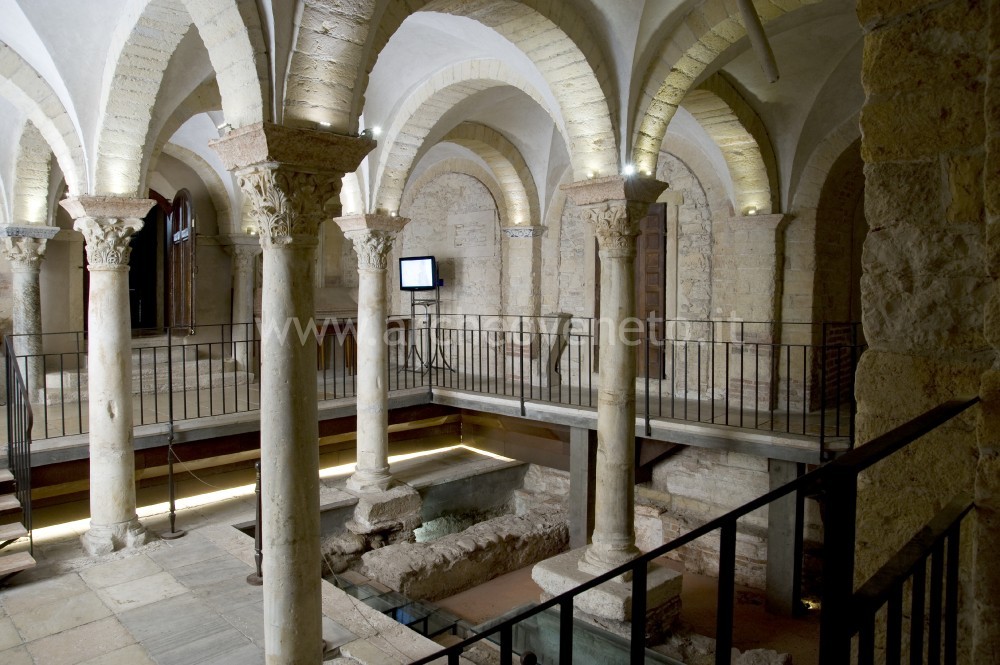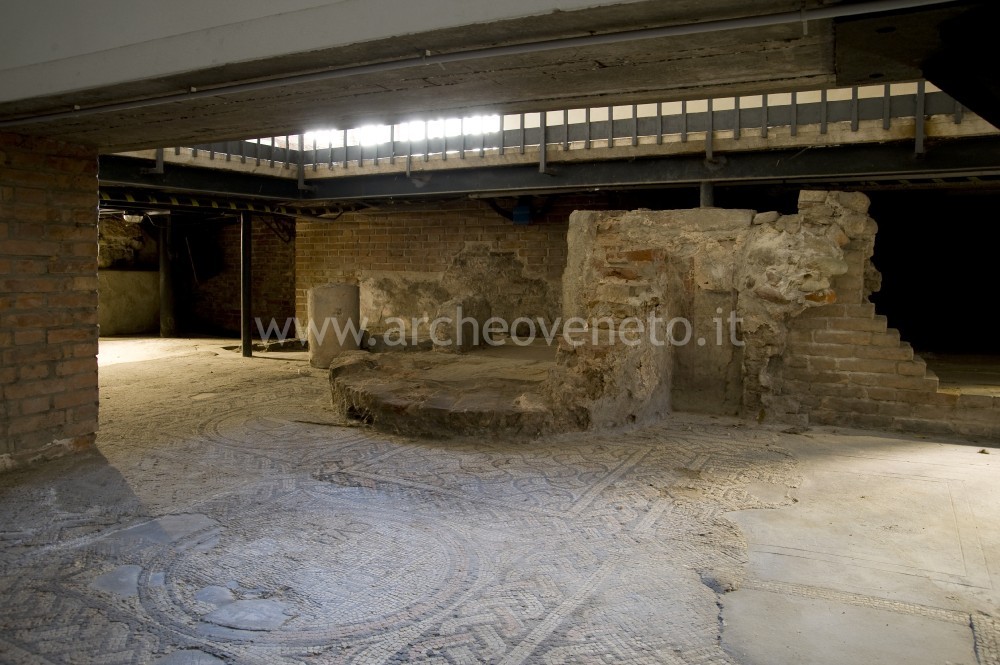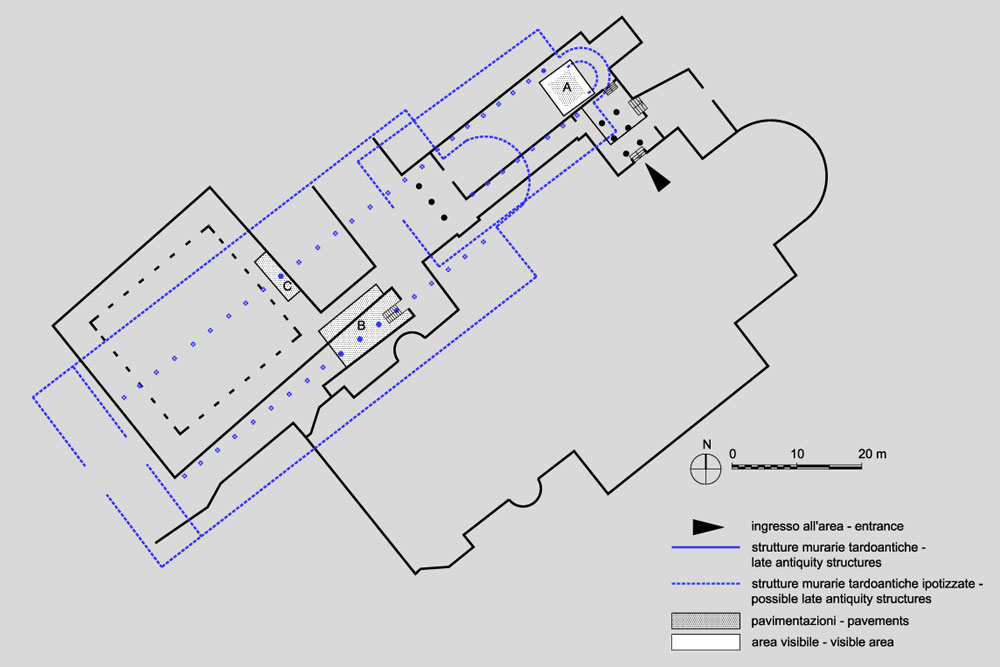|
|
File
Late antiquity religious buildings in the Cathedral – Verona
|
| Piazza Duomo (Cathedral of Sant’Elena and cloister "Capitolare") – 37100 Verona (VR)
|
  |
|
Summary

The archaeological area in the cathedral of Saint Elena and the cloister “Capitolare” includes the remains of the two early Christian basilicas, the most ancient document of Christian cults in Verona.
History of research
The first discoveries at the cathedral of Saint Elena date back to 1727, when a piece of pavement from the V century A.D was discovered. Between 1884 and 1888 this church was excavated in its full width, whereas the excavation of the hall was carried out in 1946. The finding of the most ancient church is rather recent: in fact, it was discovered and investigated between 1965 and 1969.
Urban and geographical context
Verona is located along the Adige river, where this enters in the Po plain, at about thirty kilometres east to the Garda lake. Its altitude is 59 metres above sea level and it is placed at the basis of the Lessini mountains. The archaeological area is in the core of the historic centre of Verona, just inside the Adige river bend and not far from the bridge “Ponte Pietra”. With respect to the ancient settlement, the cathedral fit in a Roman block and, although far away from the forum, it was located in an area of no less importance within the urban topography.
Chronology
IV-V century A.D. |

 The remains which are conserved within this archaeological area are the most ancient document of the Episcopal compound in Verona, which dates back to the IV century A.D. The most ancient church, commonly called “church A” was found north-west to the modern cathedral, underneath the church of Saint Elena. It was built in mid IV century A.D. over a private Roman building and it was further renovated in the second half of the same century. What we can see today belongs to the renovation of the second half of the IV century. The church was a single-apsed room divided into three naves by columns, probably alternated to pillars. The pavements in polychrome mosaics and today it is possible to see the one in the presbytery, with its squared podium that raised 30 centimetres from the ground and with pavement heating system (A). Within the mosaic, a braid identifies four sectors and a circle at the centre, hosting an inscription in small black cubes. Other inscriptions were found in the mosaics of the north-western nave. These mosaics are currently conserved below the monks’ houses and recall the names of those who paid for them as a gift to the church. The remains which are conserved within this archaeological area are the most ancient document of the Episcopal compound in Verona, which dates back to the IV century A.D. The most ancient church, commonly called “church A” was found north-west to the modern cathedral, underneath the church of Saint Elena. It was built in mid IV century A.D. over a private Roman building and it was further renovated in the second half of the same century. What we can see today belongs to the renovation of the second half of the IV century. The church was a single-apsed room divided into three naves by columns, probably alternated to pillars. The pavements in polychrome mosaics and today it is possible to see the one in the presbytery, with its squared podium that raised 30 centimetres from the ground and with pavement heating system (A). Within the mosaic, a braid identifies four sectors and a circle at the centre, hosting an inscription in small black cubes. Other inscriptions were found in the mosaics of the north-western nave. These mosaics are currently conserved below the monks’ houses and recall the names of those who paid for them as a gift to the church.
Around mid V century A.D. the most recent basilica was built south to the previous one, in a place which today is partially occupied by the cloister “Capitolare”. This basilica, which is normally defined “Church B”, was divided into three naves by two rows of 18 columns each and it was preceded by a narthex. The two lateral naves were paved in polychrome mosaics with geometric and naturalistic patterns. The central nave ended in a semicircular apse and it was crossed by a raised lane that was closed by a frescoed parapet and paved in mosaics. This lane, which is called “solea”, was built around mid V century A.D. for liturgical needs and it can be seen under the passage leading to the cloister (B, C). On the two sides of the lane the mosaic pavements describe squares containing the names of those who paid for them as a gift to the church. The narthex was also paved in mosaics, but it is not visible today because it is located underneath the monks’ houses.
|

Admission: Negli orari di apertura
Ticket: Si
Price: 2,50 Euro
 School access School access
Opening Days
| Tipology |
When |
Specs |
| Mar-Oct |
Domenica |
13.30-17.30 |
| Mar-Oct |
Friday |
10-17.30 |
| Mar-Oct |
Saturday |
10-17.30 |
| Mar-Oct |
Thursday |
10-17.30 |
| Mar-Oct |
Tuesday |
10-17.30 |
| Mar-Oct |
Wednesday |
10-17.30 |
| Nov-Febr |
GiovedìThursday |
10-13 |
| Nov-Febr |
Wednesday |
10-13 |
| Winter |
Friday |
10-13 |
| Winter |
Saturday |
10-13 |
| Winter |
Sunday |
13-17 |
| Winter |
Tuesday |
10-13 |
In orario invernale l’area archeologica non è accessibile al pubblico.
Recommended tour time (minutes): 60
 Brochure Brochure
 Information boards Information boards
 Multilingual ads: Inglese Multilingual ads: Inglese
Brochure
| Forlati Tamaro B. 1971, Scavi e scoperte negli ultimi dieci anni nelle Venezie, 1958-1968, in Atti del II Congresso Nazionale di Archeologia Cristiana (Matera, 25-31 maggio 1969), Roma, pp. 185-197. |
| Mangani E., Rebecchi F., Strazzulla M.J. 1981, Emilia, Venezie (Guide Archeologiche Laterza), Bari, pp. 168-169. |
| La cattedrale di Verona nelle sue vicende edilizie dal secolo IV al secolo XVI 1987, a cura di Brugnoli P., Venezia, pp. 22-78. |
| Archeologia a Verona 2000, a cura di Bolla M., Milano, pp. 52-57. |
| Bonetto J. 2009, Veneto (Archeologia delle Regioni d’Italia), Roma, pp. 446. |
|

